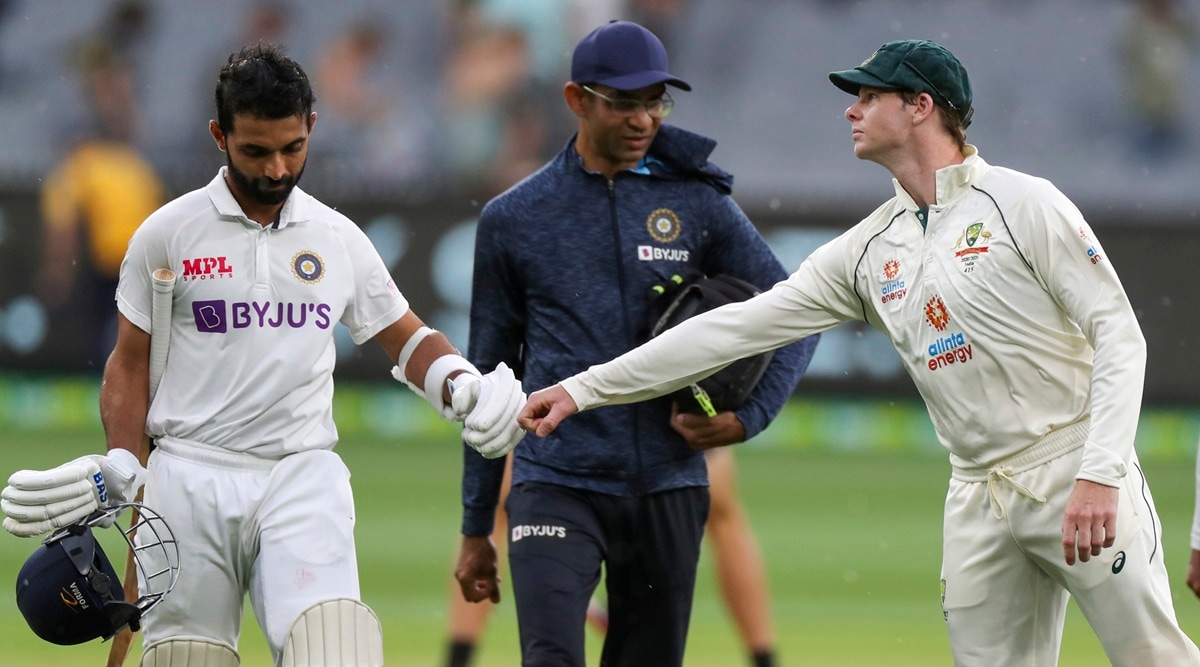Packing the onside and starving Aussie batsmen of scoring opportunities has worked for India.
At some point before the Melbourne Test, Bharat Arun, India’s bowling coach, reminded his team of a point he had made before the first Test. ‘If Steve Smith wants to score 50 runs, let’s make him play at least 200 balls. When we try to aim for the outside edge and bowl on the fourth or fifth stump line when there is not much movement in these conditions, the Australians keep scoring through the offside. Let’s change that this time’. Words to that effect.
It was a simple change: Pack the legside, bowl at the stumps. It came down to four or five men prowling on the onside. One at short midwicket; another squarer, closer to square-leg; another at leg gully; and a fourth down at fine-leg. Often, a fifth man floated some way in from the boundary at deep square-leg. ‘If you keep more men on the legside and in attacking positions, it can restrict the shots,’ was India’s theory.
Both attacking and defensive options for the batsmen were made to feel like a risk, a feeling produced by repetition from the bowlers. As the balls piled up on the nagging line and the layers built up further with the fields set, the batsmen started to check themselves. Especially, after the trap produced a wicket. Like it did with Marnus Labuschagne in the first innings at the MCG. On 48, he flicked Mohammed Siraj around the corner, only to find a couple of Indian palms, cupped and waiting.
The batsmen’s self-censure hardened after that. What if I flick and can’t keep it down? What if I miss an attempted flick across the line and fall to the LBW trap? Is that deepish square-leg hovering for a weak hook off a bouncer, or is that a double bluff for the full LBW ball? The negative thoughts piled up. As did dot balls and the pressure. Something had to give. Especially, as modern-day batsmen’s temperament isn’t exactly made to outlast. A false shot comes too soon. Often, they don’t even counterattack, unable to bring themselves to dare the what-if. Barring Smith, and in the absence of David Warner, probably only Matthew Wade could have thought about attacking but his first-innings dismissal in Melbourne – when he charged out at Ravichandran Ashwin to hole out – put paid to that approach and he grafted along in the second dig.
The simple plan gained momentum, as memories of past dismissals (like Labuschagne’s in the first innings) or fretful intimations of future trouble forced tentativeness into minds.
What’s most unusual about India’s tactic was how long they managed to sustain it. They did it briefly on the 2018-19 tour of Australia, incidentally at the MCG in the third Test when opener Aaron Finch flicked a straight one from Ishant Sharma to short midwicket. They seem to have used the learnings from the previous tour and extended it for longer periods now.
Like Siraj’s spell against Cameron Green in the first innings. For eight overs, either side of the tea break, he kept at it. More than most others, Green seemed equipped to handle it as he got his hands ahead of the pad and bunted the ball to short midwicket. In his seventh over, Siraj started to reverse the ball away, and after a series of six away-seamers, he tailed one in to nail Green LBW.
The simple plan of bowling straighter lines was made to feel like a provocation.
***
In the past, it’s been the Aussies who have used such provocation. In 2004, when they returned to India without Steve Waugh after his earlier failure at the last frontier, the fast bowlers led by Glenn McGrath and Jason Gillespie chalked out the plan to bowl straighter lines. Two short midwickets sprouted, often to the likes of VVS Laxman. Runs trickled down. Aerial risk escalated. The noose tightened.
Even further back, they have deployed it memorably to the likes of Mohammad Azharuddin. David Boon at deepish and squarish short-leg conjured catches off Azhar’s flicked blurs. Of course, it was an Australian Keith Carmody who even had a field-setting named after him – the Carmody field – when he pioneered an umbrella grouping in the late 1940s, with men in the arc spanning from conventional gully to leg gully.
Indians didn’t populate the arc quite like Carmody but used the leg gully particularly well. In particular for three batsmen – Smith, his shadow Labuschagne, and Green. Of the three, the taller Green with his longer reach was willing to keep tapping to the onside.
Labuschagne was more circumspect. He is similar to Smith in many ways, but there are also a few differences. Unlike Smith, he doesn’t seem to like getting on the front foot, at least on the evidence of this series. He prefers to either move sideways on the crease or hang back. To spin and pace. Both moves make the straighter lines ideal and more potent.
The sideway shuffles of Smith and Labuschagne do make it tougher for them, in theory. As they move towards off, the ball on the stumps makes them arrest the movement and hold balance. Additionally, because of the close-in catchers, they need greater care to keep the ball down when they try to wrist it to the onside on the move. Labuschagne’s pull shot isn’t flash either and keeps the floater in the deep square-leg region interested. With the risks escalating (he can’t pull or flick without the fear of getting caught), the dot balls and pressure just keeps building up. Indian pacers’ plan won’t be too dissimilar to Smith, though he has a lot wider skillset to counter it.
ENGLAND’s PLAN TO SMITH
India’s strategy is something that Joe Root, England’s captain, tried against Smith in the last Ashes series in England, although sparingly. But something he hinted at, in the podcast The Analyst this October, is that he would use it for longer and more often in the future.
“You look at the field we had for him at (first Test at) Edgbaston. We had a leg-slip. The ball was two yards away from Ben (Stokes), and it ended up going for a four. If we had him a yard or two yards finer, we would have had him in the shed for a naught. The series could look really different,” Root says.
But England didn’t press on with the field consistently enough or use it with the lines it needed. “In the last Test, we went back to it – I was quite strong that’s the thing I wanted for him with our attack – and he ended up getting caught at leg-slip. When someone bats like him, quite differently, as a captain you got to think differently and be quite open to go to different plans as a bowling group … danger ball for someone with more orthodox technique doesn’t seem to be an issue for him,” Root says. “In the next couple of years, sides will start to do a lot more different things, try different fields, make him think differently about how he is going to score runs.”
That’s what India have done to Labuschagne and Green; it’s also something they would have undoubtedly done more to Smith had he lasted longer against Ashwin, who used a similar strategy to an extent. If it was the quickish skidder in the first Test, it was the ball spinning down leg that lured Smith to trespass into areas from which he couldn’t extricate his hands in time.
Warner comes in for the third Test but considering it’s a traditionally spin-friendly track in Sydney, India could well attack him with Ashwin early on, like they did in the 2017 series in India. Under pressure on tracks that turned that series, Warner turned mute, pushing and prodding – and perishing. Australia’s batting fortunes could well come down to whether he has the confidence to counter-attack Ashwin. And of course, on how Smith and rest tackle the bowl-straight-with-packed-legside plan of the Indians.
Source: Read Full Article



